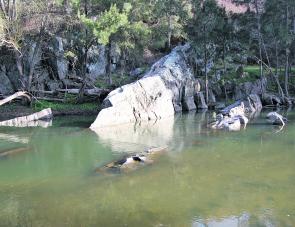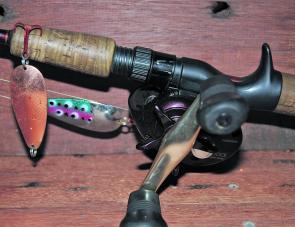For the most part, to catch fish consistently in February on the Central Tablelands it’s necessary to keep crazy hours. By this I mean being on the water pre-dawn for trout and native species, and fishing through until first light and a bit after, as this is when fish will be most active. Sure you can stay out, change tactics and still catch some, but you will have seen the best of it early.
Trout quickly move to deep water once the sun is up. Some may not even move from the depths at all over summer, happy and content to work the thermocline, harassing baitfish, tiny water fleas and the like. To catch these trout you have to be in the zone and this could be down 40’ or more in deep waters such as Lake Lyell and Thompsons Creek Dam (TCD). Reaching those depths at Lyell on a consistent basis is best done out of a boat, but with no boat access on TCD, it’s very hard, with only a few locations being a possibility from the bank.
Downrigging and deep fly fishing using full sink fly lines are 2 methods that can be used on Lyell with some success on these thermocline-hugging fish, but it’s not something I have done a lot of recently. Both methods are used extensively overseas and in the Snowy lakes, so do yourself a favour and check out some of the stuff on the Internet regarding these subjects — it’s a real eye opener.
Working the banks at TCD means finding the deepest water possible closest to the bank, but not the wall, as this is a no-go zone. The quarry on the western bank is one such spot, and casting heavy spoons, letting them flutter to the bottom, then ripping them back up to flutter back down again can produce some savage strikes. Casting Tassie Devils, letting them sink, followed by a slow retrieve, can also work at times.
Hopefully the bass bite will continue, although it’s frustrating at times with the weather conditions. It’s been an okay season thus far and water traffic in Lyell makes it tough during the warmer months, but if you keep to those crazy hours you should do well. Look to be off the water before the melee starts!
Where you are fishing can mean a big difference in tackle selection. Save the light gear for the open water and rocky banks, as when in amongst the drowned black wattle it’s title fight stuff. Use 10kg braid and 7kg leaders minimum, and don’t say I didn’t warn you. I’ve gone back to a mono leader to add some shock absorption in the equation. With a less than 50% average on landing these things, it got me thinking (my wallet was screaming at me too) that with a high modulus graphite rod, braid, a locked drag and a fluorocarbon leader there is very little give in the tackle setup. The bass where hitting that hard and that quickly, they were breaking us off on the strike (their strike, not mine). On a straight retrieve rod tip down pointing back at the lure, the rod doesn’t even get a chance to get into a working curve. Just my thoughts, but the next step is an old school fiberglass rod and just get it bent to the corks.
What a rush; one second your lure is paddling slowly along the surface, the next minute there’s a hole in the water where your lure once was and you’re shaking like a leaf. It’s an adrenalin fix that needs no fixing!
Early morning at this time of year has the edge, I reckon. The cod know that it’s going to be a long, hot day parked up in the shade, so it’s a case of better get a feed as soon as possible. Multiple strikes on the same retrieve, sometimes by different fish, shows competition for food in some pools can make cod do crazy stuff.
With a lot more water surrounding them in the lakes, competition is not quite as intense. Good structure in the right location in waters such as Wyangala and Burrendong will always hold the best fish though. Keep in mind the best looking areas above the waterline will be the hardest hit, so look for those little spots that are not quite as noticeable. Use your sounder, use your sounder, I will say it again, use your sounder. Find the structure, and if it means keeping the rods in the boat while you look for it, then so be it. Mark your spots, spend a few hours doing it during the middle parts of the day when it’s quiet, then go back in prime times and hit them hard. Jump from one to the other maximise your time.
Reads: 1083
Sometimes you win, most times you lose. With some tackle adjustments made, we might see a few more bass of this size. Great fish Muz, the fight was a pleasure to watch.

Cod structure in creeks and rivers can take many forms. Rocky reefs such as this one are good; in combination with a good log pushed up against a front face it’s even better.

Trout find fluttering spoons at depth hard to resist at this time of year. Simple and effective, I like it.




